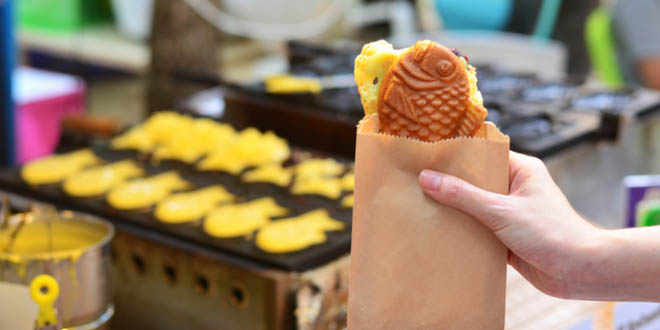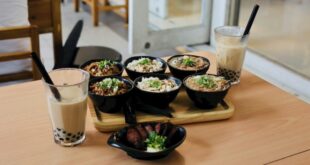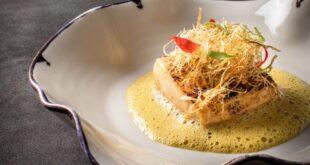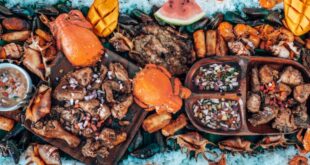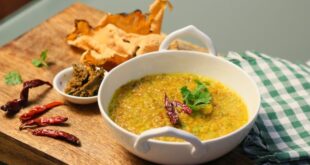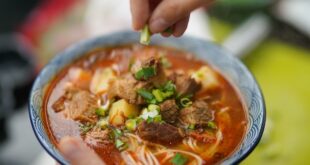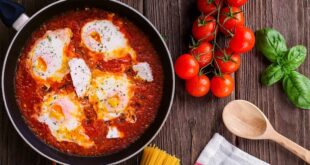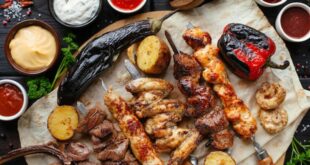Last Updated on February 7, 2023
If you are ever in Seoul, South Korea, you may hear someone rushing by to catch the bus yell loudly, “Ppalli ppalli (빨리 빨리).” This quickly-turned phrase means “hurry, hurry” in Korean. It is a defining feature in the fast-paced life of South Koreans, especially in the cities. It is not surprising, therefore, that South Korea has a wide variety of street foods to snack on, treat to, or even make a meal out of while busy passersby shop, explore, and “ppalli ppalli (빨리 빨리).” While some of them might remind you of Japanese street foods, these top 10 Korean bites will knock your socks off while you are on-the-go.
TAKEAWAY: If you want to try the most authentic versions of the following Korean street foods in Seoul, you must visit the Namdaemun, Dongdaemun and Gwangjang markets. The Gwangjang market is, since 1905, the oldest market still functioning in South Korea.
Pajeon |파전 (Korean Pancake)
Unlike the sweet pancakes with syrup found in American households, Korean pancakes are savory. Pajeon is made with many different vegetables and meats, but the main ingredient that defines this crispy dish is the green onions. Many pajeon recipes call for seafood, such as squid, octopus, or shrimp. The batter is a mix of flour, egg, water, oil, and salt. It takes only about 10 minutes to whip this crispy Korean flapjack up in a skillet. That’s why, it is a dish that appeals to the masses in Korea, especially for those who wish to tear and share as they take a breath on their daily commute through the city streets.
Kimbap | 김밥
Kim (김) is the Korean word for seaweed. Bap (밥) is the Korean word for rice. Kimbap is similar to Japanese sushi in respect to rolling rice up into a roll with a sheet of seaweed. However, kimbap does not have raw fish in it. Often, this dish incorporates ham or beef as the meat. Kimbap is also known for being colorful with vegetables like carrots, eggs, radishes, and greens – talk about eating with our eyes! Kimbap is one of those dishes that you don’t have to wait long to get either. Many people eat it as a late night snack when they have been out and about enjoying the nightlife in South Korea.
Mandu | 만두
Man-du, man-du, man-du, man-du! Mandu is the dish that keeps on giving, and people never want it to stop giving. This savory little pocket of warmth and yummy golden goodness is a staple in not only Korea but broader Asian cultures as well. Many people recognize mandu as dumplings.
Mandu is a bite-size portion of pan-fried, diced meat and vegetables tucked inside a thin flour dough. Then, the dough is rolled out in a circle. When the meat and vegetable mix is placed inside of it, half of the dough is folded over it, and the edges are pinched shut. The mandu is either pan fried, deep fried or boiled. Most people will dip it in a soy sauce mix to bring out the savory flavors even more. It’s bite-size, too, so take it with you as you hurry to your next destination.
Tteokbokki | 떡볶이 (Spicy rice cake)
If there is a street food that is decidedly Korean, it’s tteokbokki (pronounced duck-bow-kki). Korean food has strong flavors in it, and tteokbokki does not shy away from them. This dish has distinct flavors and textures: spicy, sweet, chewy, savory, nutty, smooth… It is made with cylindrical rice cakes, fish cakes, green onions, and cabbage. These ingredients are stewed in an anchovy broth that has red chili pepper paste, sugar, garlic, soy sauce, and sesame oil. This dish is not for the faint of heart since it is hot in regards to temperature and taste. There isn’t any hidden spice though – the dish is served in a bright red sauce on a plate with toothpicks handy.
Twigim | 튀김 (Battered gimpap)
Just like the description says, twigim is gimbap that is battered and fried. Basically, this is a type of tempura. Who doesn’t like tempura fried foods? These snacks are a Korean street food for those testing the waters. With twigim, the ingredients list is endless. Street vendors include all kinds of seafood, meats, and vegetables in their twigim recipes. They usually sell this food on skewers for ease of access. If you are uncertain of Korean food, this one is sure to start you off right – you can’t go wrong with fried and battered.
Gyeranbbang | 계란빵 (Egg Bread)
Egg bread is a popular street food for the winter months. It is comfort food to the max with a whole egg snuggled inside of a toasty bread similar to corn muffins. For these reasons, this dish is just the right amount of sweet and salty. Usually, the vendors cook the batter for the bread in an oblong mold. They also crack the egg over the top of the bread, so people can see the egg yolk. Egg bread is easy to make and could even be breakfast on-the-go.
Soondae | 순대 (Blood Sausage)
Let’s be honest, blood is never at the top of anyone’s list of gotta try foods. Soondae, however, is definitely one of those must-try Korean street foods. The main stars in this dish are pork blood (surprise, surprise) mixed with cellophane noodles and glutinous rice. This makes for a gummy texture. Although the sausage is mild in taste, it is enlivened by sugar, salt, chili powder, sesame seeds, and ground shrimp. Many times, people pair soondae with tteokbokki. Eating soondae is a unique and iron-rich experience for the adventurous taste buds!
Bungeoppangs | 붕어빵
Unlike the savory items on the list so far, bungeoppang is a sweet street treat. It is a batter recipe similar to waffles with sweet red bean paste stuffed inside of the bread. Vendors use a fish-shaped griddle to cook the batter and red bean paste. This food comes to the buyer crispy, sweet, and doughy all wrapped up in paper for a munching delight. Variations of this dish include using the fish waffle like an ice cream cone. Topped in the mouth of the fish are scoops of ice cream and garnishes like Pocky Sticks or mochi. Go ahead, have two!
Hotteok | 호떡
Hotteok is a sweet pancake with a brown sugar syrup filling. There are several variations of this food from adding cinnamon and chopped walnuts to the syrup to topping the pancake with a dollop of ice cream. Hotteok is one of those scrumptious foods eaten in the autumn and winter months when it’s crisp outside. Hotteok will be handed to you wrapped in a napkin or stuffed in a cup. It makes commuting easy and sweet.
Various Skewered meats
There is probably nothing more appealing to people than sizzling meat on a stick. Among the many things you can carry around the streets, skewers of meat are top for Koreans. Vendors grill the meat right in front of customers so that they can tell them how they want it cooked or what sauces to add. This is a food that is often eaten late at night after people leave the bars.
On the bustling streets of Seoul, South Korea, you will find all of these fares in the hands of people going ppalli ppalli. However, I have only scratched the surface of Korean street food in this article. There are variations of all of the foods mentioned as well as other delicious foods.
 Travel for Food Hub The Food Blog for Travel Lovers
Travel for Food Hub The Food Blog for Travel Lovers

